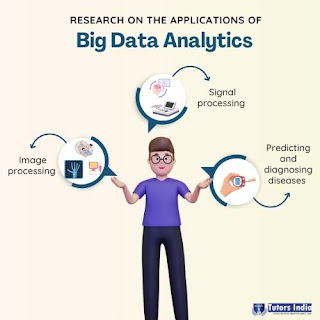A Step-by-step Guide To Data Analysis Mastering The Art For Successful Dissertations
In This Essay, We Explore The Field Data Analysis And Present A Thorough, Step-by-step Methodology That Should Assist Aspiring Researchers In Writing Strong Dissertations. We Are Aware Of The Irritation That Can Result From Data Analysis's Many Difficulties, From Data Collection To Interpretation. Rest Assured, Though, That By The End Of This Essay, You Will Have Learned Priceless Insights And Useful Advice To Master The Craft Of Data Analysis, Empowering You To Confidently And Accurately Handle Even The Most Challenging Datasets. Join Me As We Set Off On This Transforming Trip.
Introduction
One Frequently Faces A Variety Of Obstacles When Starting
The Road Of Writing A Dissertation. One Such Challenge Is Becoming An Expert In
Data Analysis, A Necessary Skill For Carrying Out Relevant Research And
Arriving At Reliable Results. Effective Data Analysis Not Only Makes Your Work
More Credible, But It Also Enables You To Spot Insightful Patterns And Trends
That Have A Big Impact On Your Field Of Study.
We Will Walk You Through A Step-by-step Process To Mastering
The Art Of Data Analysis In This Thorough Book. This Article Intends To Provide
You With The Skills And Strategies Needed For Effective Dissertations,
Regardless Of Your Level Of Research Expertise. We Will Offer Insightful Advice
On Everything From Selecting The Best Research Question To Using Sophisticated
Statistical Techniques, Sure To Improve Your Data Analysis Skills.
Choosing the
Right Research Question
The Correct Research Question Must Be Chosen In Order To Be
Successful Because Data Analysis Is A Difficult And Subtle Field. Throughout
The Entire Process, It Serves As A Compass To Steer Your Efforts And Shape Your
Conclusions. It Is Crucial To Choose A Research Issue That Is Not Just
Challenging Academically But Also Useful And Pertinent To The Field.think About
The Significance Of Your Research Question In Relation To The Bigger Picture Of
Your Discipline. Choose A Question That Addresses Knowledge Gaps Or Contradicts
Accepted Thinking. Not Only Will This Pique Your Interest, But It Will Also
Make A Significant Contribution To The Academic Community.
Understanding
the Research Design
Understanding The Research Design: In This Important
Section, We Explore The Complexities Of Research Design, A Critical Element Of Any
Effective Dissertation. Here, We Help Aspiring Academics Choose The Best
Methodology And Paradigm For Their Research By Navigating The Confusing World
Of Methods And Paradigms. Researchers Must Rigorously Develop Their Study
Design To Lay A Solid Foundation For Their Investigations, Much As An
Experienced Architect Diligently Plans Every Part Of A Building To Ensure Its
Stability And Functionality.
This Section Contains A Gold Mine Of Information On Several
Research Designs, Including Experimental, Correlational, And Qualitative
Methods. We Examine The Benefits And Drawbacks Of Each Design Option While
Shedding Light On How They Relate To Various Research Objectives. We Enable
Researchers To Make Selections That Maximize The Rigor And Validity Of Their Studies
As Well As Their Enthusiasm For Knowledge Exploration By Offering An In-depth
Analysis Of These Alternatives.
Collecting and
Preparing Data
Gathering And Preparing Data: The First Step In Attempting
To Solve The Mysteries Concealed Within Huge Datasets Is To Gather And Prepare
The Data. In This Process, Painstaking Care Must Be Given To Ensure A Plentiful
Harvest Of Insights, Much Like A Rich Garden That Needs To Be Tended.
Researchers Set Out On A Voyage Of Data Collection With Extreme Precision, Using
A Variety Of Techniques Including Surveys, Interviews, Or Experiments Tailored
To Their Particular Study Subject.
Once Collected, This Raw Data Serves As The Background For
Insightful Analysis. Before Revealing Its Genuine Essence, It Needs To Be Prepared
With Delicate Brushstrokes. Cleaning Procedures Are Used To Get Rid Of
Anomalies And Discrepancies That Could Compromise The Validity Of The Results.
Researchers Ensure An Accurate Depiction Of Reality By Painstakingly Sorting
Through Each Datapoint With A Dedication Equal To A Skilled Artisan Perfecting
Their Creation.
Data Cleaning
Techniques
Employing Efficient
Data Cleaning Strategies Is Essential For Ensuring The Accuracy And
Integrity Of Your Study Findings. This Important Stage Entails Locating And
Fixing Mistakes, Discrepancies, And Outliers In Your Dataset. By Getting Rid Of
These Artifacts, You May Confidently Move Forward With Your Analysis Knowing
That Your Results Are Supported By Trustworthy Data.
One Well-known Method Of Cleaning Data Is Outlier Detection.
Extreme Values That Significantly Deviate From The Data's Average Pattern Are
Known As Outliers. In Order To Prevent Outliers From Skewing Results And
Leading To False Conclusions, It Is Crucial To Recognize Them And Handle Them
Properly. These Anomalies Can Be Found Using Statistical Tools Like Z-scores Or
The Interquartile Range (Iqr), And You Can Choose Whether To Eliminate Or
Adjust Them As A Result.
Hypothesis
Testing
Testing Hypotheses: In The Context Of Data Analysis, Testing
Hypotheses Is Essential For Assessing The Reliability Of Research Claims And
Arriving At Insightful Findings. Creating A Null Hypothesis, Which Presupposes
That There Is No Meaningful Association Between The Variables, And An
Alternative Hypothesis, Which Suggests There Is, Is Required. The Objective Is
To Gather Data To Statistically Either Reject Or Fail To Reject The Null
Hypothesis. Hypothesis Testing
Reveals Hidden Information And The Truth Buried In The Data With A Dash Of
Statistical Wizardry. It Enables Researchers To Confidently Assert Their
Conclusions, Supported By Strong Data And Meticulous Analysis. Hypothesis
Testing Sets The Way For Ground-breaking Discoveries And Opens Doors To New
Possibilities By Challenging Preconceived Beliefs And Investigating Alternate
Explanations.


Comments
Post a Comment